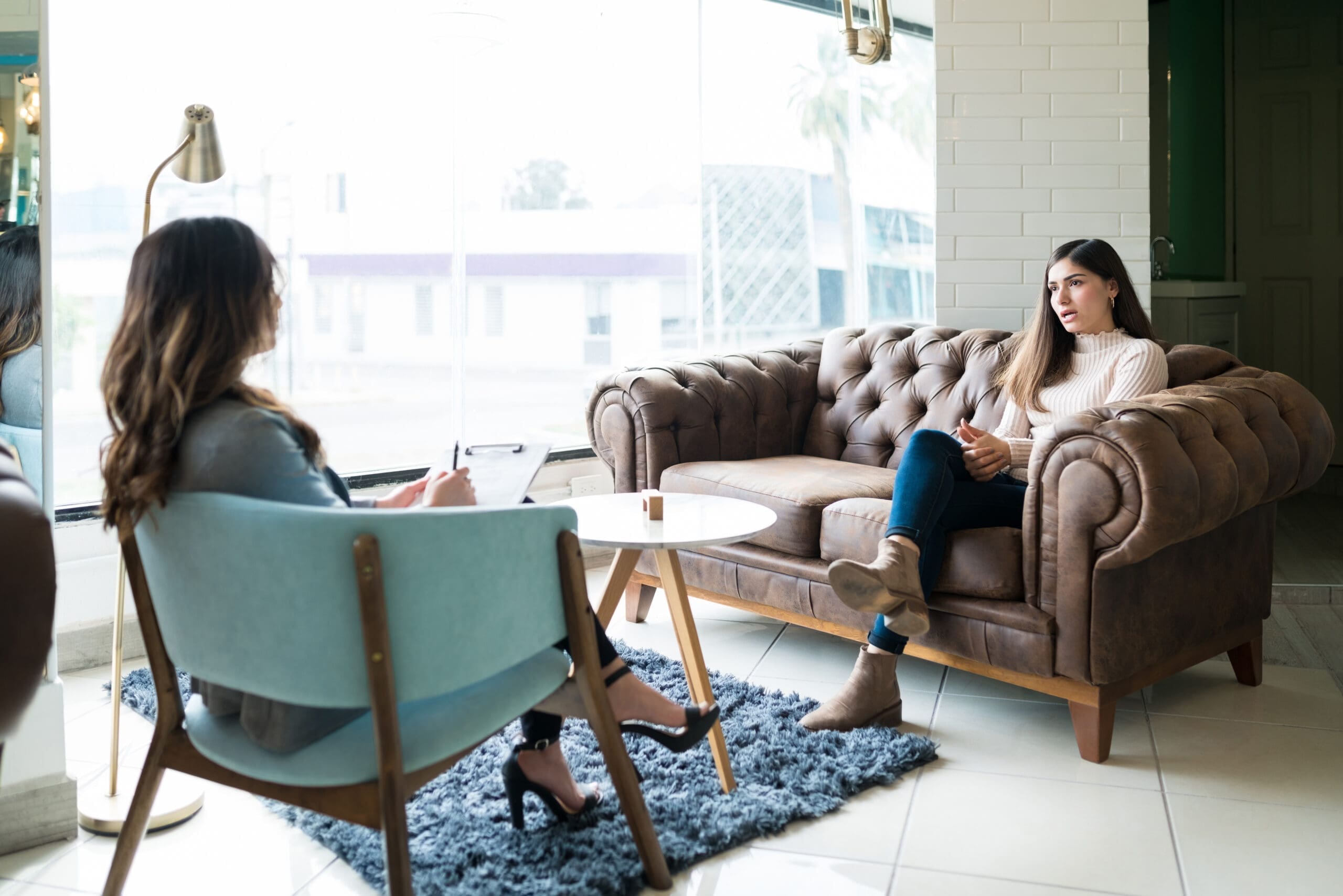In this post
In counselling, the relationship between the counsellor and client can be as important as the techniques used. It is the cornerstone of effective intervention, can profoundly impact counselling success and is critical in facilitating positive change.
A strong relationship is built on trust, mutual respect and empathy; it creates a safe and supportive environment where clients feel understood and valued. They are more likely to feel comfortable opening up and exploring their thoughts, feelings and experiences, and it encourages them to engage fully in the counselling process. Without a strong therapeutic bond, the effectiveness of counselling interventions and techniques can diminish, affecting clients’ progress and therapeutic outcomes.
This blog aims to explore why relationship building is crucial in counselling and how counsellors create a safe and supportive environment, which is vital for clients’ self-discovery, emotional healing and personal growth. By examining the dynamics of the counsellor-client relationship, we can appreciate its profound impact on the counselling process and overall mental well-being.
What Is the Therapeutic Relationship?
The Greater Manchester Mental Health NHS Foundation Trust defines the therapeutic relationship as:
“The therapeutic relationship (also therapeutic alliance, the helping alliance, or the working alliance) refers to the relationship between a healthcare professional and a client (or patient). It is the means by which a therapist and a client hope to engage with each other, and effect beneficial change in the client.”
The therapeutic relationship is often referred to as the therapeutic alliance, which highlights its collaborative nature and emphasises the partnership between the counsellor and client in working towards the client’s goals. Antoniou (2024) details signs of a strong therapeutic alliance in an article here.
This relationship has key characteristics: trust, empathy, mutual respect and collaboration, and it plays a pivotal role in the counselling process.
- Trust – is the bedrock in which the therapeutic relationship is formed. Clients need to trust that their counsellor has their best interests at heart, will maintain confidentiality and provide a safe space for them to share their thoughts, emotions, experiences, and feelings. It will make them feel safe and supported and more likely to open up. Trust is not instant. It develops gradually through consistent, respectful and honest interactions.
- Empathy – according to Miles (2023), empathy is the ability to recognise, identify and understand the situations that clients are experiencing and to understand their feelings, ideas and motivations. It involves counsellors actively listening, showing genuine care and concern and putting themselves in their client’s shoes, which helps clients feel understood and validated.
- Respect – both parties should respect each other’s boundaries, values and feelings, fostering an environment of mutual respect. Counsellors should value their clients’ autonomy and ability to make decisions for themselves and honour their choices and views. Respect also involves maintaining a non-judgmental attitude, allowing clients to express themselves freely without fear of criticism.
- Collaboration – the therapeutic relationship is a collaborative effort. Counsellors and clients should work together to set goals (DeAngelis, 2019) and develop strategies for achieving them. Clients should actively participate in their own treatment plans, fostering a sense of ownership and empowerment and promoting healing and growth.
The therapeutic relationship is fundamental for counselling success. It creates a foundation of trust, safety and a supportive environment, allowing clients to explore difficult issues, gain insights and make positive life changes.

Why Is Relationship Building Important in Counselling?
Relationship building is vitally important in counselling for many reasons, and here are some examples:
- It facilitates open communication and honesty – clients who feel more connected and comfortable with their counsellor are more likely to open up and communicate openly and honestly, sharing their true thoughts, experiences and feelings. This transparency is essential for addressing the underlying issues, working towards meaningful change, and ensuring effective counselling. The counselling process can be hindered without honesty and openness, as the counsellor may not have all the necessary information to provide appropriate guidance and support.
- It helps clients feel safe and understood – a supportive therapeutic alliance fosters a safe and secure environment where clients feel understood, respected and accepted. When clients feel safe, they are encouraged to explore their emotions, thoughts, experiences and feelings without fear of judgment and are more likely to feel comfortable discussing sensitive topics. A counsellor’s empathy and active listening skills are significant in fostering this sense of safety and understanding.
It builds trust – trust is fundamental for any effective counselling relationship. Clients who trust their counsellor are likely to share sensitive information or painful issues and trauma, which is crucial for deeper exploration and healing. Trust also encourages clients to follow through with therapeutic interventions and strategies suggested by the counsellor.
It is linked to positive therapy outcomes – research consistently shows that a strong therapeutic relationship is one of the best predictors of positive counselling and therapy outcomes. Clients who feel connected to their counsellor are more likely to be satisfied, engage in therapy and achieve their goals. Here are some studies that reinforce this point:
- The British Association for Counselling and Psychotherapy (BACP) publication “What Works in Counselling and Psychotherapy Relationships” highlights that the quality of the therapeutic relationship is a significant predictor of positive outcomes.
- Seewald & Rief (2023). Therapist’s warmth and competence increased positive outcome expectations and alliance in an analogue experiment.
- Stubbe (2018). The Therapeutic Alliance: The Fundamental Element of Psychotherapy.
- Wilmots et al. (2019). The therapeutic relationship in Cognitive Behaviour Therapy with depressed adolescents: A qualitative study of good‐outcome cases.
Building this kind of relationship takes time, empathy and genuine care from the counsellor, but it is undoubtedly one of the most important aspects of successful counselling.

Core Skills for Building a Strong Therapeutic Relationship
Building a strong therapeutic relationship is no easy feat. It requires counsellors to possess specific core skills, including empathy, active listening, genuineness (congruence) and unconditional positive regard.
Empathy
Empathy involves the counsellor seeing the world through their client’s eyes and recognising and understanding their thoughts, feelings and experiences. It is about genuinely understanding their perspective without making assumptions or passing judgment. It helps build trust and makes the client feel heard and valued.
Some techniques that counsellors can adopt to convey empathy include:
Reflective listening
- It involves the counsellor mirroring their client’s words and feelings to demonstrate understanding, i.e. summarising or paraphrasing what the client has said to reinforce that the counsellor is fully engaged.
- For example, a counsellor could say, “It sounds like you felt really overwhelmed in that situation.
- Counsellors can reflect the client’s emotions back to them to validate their feelings, e.g. “It’s okay to feel that way.”
Using open-ended questions
- Counsellors can encourage exploration and ask questions to invite clients to share more about their thoughts and feelings. For example, “Can you tell me more about how that makes you feel?”
- Where possible, counsellors should avoid closed questions, i.e. with yes/no answers, to encourage deeper conversation.
Using empathetic statements
- Counsellors can use statements demonstrating they understand the client’s perspective. For example, “I can see how that would be really challenging for you.”
- They can also offer insights that show their understanding of the client’s situation. “It sounds like you’re feeling stuck because…”.
Jamie Clarke Counselling has some further tips on showing empathy here.
Active listening
Active listening is an important skill that counsellors can also use to convey empathy. It requires them to focus on what the client is saying and respond thoughtfully, giving their undivided attention. It is not just hearing but listening carefully, being fully present in the moment, setting aside distractions, not interrupting and considering responses carefully.
Active listening also involves using various verbal and non-verbal cues to demonstrate attentiveness and full engagement in the conversation, for example:
- Maintaining eye contact but not staring.
- Using facial expressions matching the client’s emotional state to show empathy and understanding.
- Open and welcoming body language, e.g. nodding, leaning slightly forward, and not crossing arms.
- Using short, affirming phrases like “I see”, “I understand,” “That must be tough,” or “Go on”.
- Touching comfortingly, e.g. a pat on the back or hand can convey support, but only when appropriate and consented to
Counsellors should also summarise the main points discussed to reinforce understanding and demonstrate that they were listening closely. For example, “It sounds like you’re feeling overwhelmed because of the recent changes at work.”
Genuineness (congruence)
Another important skill is genuineness, also known as congruence. It is a fundamental aspect of building a strong counselling relationship. It requires counsellors to:
- Be authentic and transparent.
- Not put up a façade but show their true selves professionally.
- Communicate openly and honestly with clients.
- Clearly express their thoughts and intentions.
- Avoid ambiguity or mixed messages.
- Ensure their verbal and nonverbal communication align.
- Be consistent in their responses and behaviour.
Congruence fosters trust, predictability and a genuine connection and models authenticity for clients.
While congruence is crucial, it is also important to balance professionalism and relatability. Counsellors can share appropriate personal feelings and experiences when it benefits the client and the therapeutic process. It can help clients feel more comfortable and see the counsellor as a person rather than just a professional. However, they must always maintain professional boundaries and ensure they do not cross them when striving to be relatable and approachable.
Unconditional positive regard
Unconditional positive regard involves accepting, supporting and valuing the client for who they are, regardless of their actions, thoughts, feelings or behaviours. When counsellors use this skill, it:
- Fosters a non-threatening environment where clients feel safe exploring and expressing their true selves without fear of judgement, rejection or criticism.
- Demonstrates deep empathy – where the counsellor tries to understand the client’s feelings and experiences from their perspective.
- Encourages clients to open up and engage more deeply in the counselling process.
- Helps clients gain deeper insights into themselves and their experiences.
- Promotes personal growth and self-acceptance, empowering clients to make positive changes.
We have a separate article with further information on unconditional positive regard here.
These core components collaborate to create a strong therapeutic relationship, enabling clients to feel understood, supported and empowered to make positive changes.

Building Trust in the Counselling Relationship
Trust is not immediate, and it can take time to build. However, it is fundamental for a strong therapeutic relationship and effective counselling. Counsellors can build trust in the counselling relationship through consistency, reliability, clear boundaries and a non-judgmental attitude.
Consistency and reliability
Consistency and reliability are key to building trust. Counsellors should:
- Ensure they show up on time. Punctuality demonstrates their commitment and respect for the client’s time and provides a routine that clients can rely on. Clients are more likely to trust someone who consistently honours their appointments.
- Follow up on previously discussed topics or agreed-upon actions to show they are dependable. If they say they will do something, they should do it.
- Always maintain confidentiality. Clients need to feel assured that their personal information is secure and they can speak freely without fear of it being shared. It is important for clients to know that their counsellor is a safe and trustworthy person.
Clear boundaries
Setting and maintaining clear and well-defined professional boundaries involves defining the limits of the relationship. It is vital in fostering trust, as it:
- Ensures that the counsellor and client understand their roles and responsibilities.
- Helps clients understand what to expect and what the counsellor expects of them. For instance, limited communication outside sessions or avoidance of certain types of personal contact.
- Creates a safe and predictable environment for clients, allowing them to feel secure.
- Prevents crossing boundaries and violations, which can potentially damage the therapeutic relationship.
It is not just about setting boundaries but also about consistently respecting them.
The BACP has further information on boundaries here.
A non-judgmental attitude
Counsellors should create a non-judgmental space where clients can express themselves freely without fear of criticism or rejection, as it encourages openness and honesty. They should also:
- Listen empathetically, acknowledge and validate the client’s experiences and feelings without passing judgment, fostering an environment of acceptance and understanding.
- Offer consistent support and encouragement helps clients to feel validated and motivated to work through their challenges.
Over time, consistently demonstrating a non-judgmental attitude helps build a strong and trusting relationship. Clients learn they can rely on their counsellor to provide a supportive and unbiased space for their healing journey.
These elements work together to create a foundation of trust, which is essential for a successful therapeutic relationship.

Overcoming Challenges in Relationship Building
It is not always easy to build relationships in counselling, and counsellors must navigate various challenges. Here are some examples of ones they may come across:
Resistance from clients – clients may feel hesitant or distrustful, especially in the early stages of counselling, which is completely normal. Counsellors can overcome this by:
- Active listening to clients makes them feel heard and validated, thus reducing hesitation.
- Consistently demonstrating patience and empathy. Small acts of kindness and understanding can go a long way in breaking down resistance.
- Giving clients the time they need to open up, as rushing them can lead to increased resistance.
- Providing a consistent, structured, and safe environment by defining clear expectations and boundaries early on.
- Demonstrating that they genuinely care about their well-being can foster trust.
Cultural differences – can impact the therapeutic relationship by influencing communication styles, trust levels, values, treatment preferences and expressions of distress. Counsellors must understand and respect these differences to build a stronger, more effective therapeutic connection, which they can achieve by:
- Being culturally competent and sensitive to clients’ diverse backgrounds and values.
- Undertaking regular training and education on cultural competence to help them stay informed and sensitive.
- Learning about different cultures, being aware of their own cultural biases, and showing respect for the client’s cultural identity.
- Encouraging open communication about cultural differences to foster mutual respect and understanding.
- Fostering an inclusive environment where clients feel understood and accepted. For example, understanding cultural norms around communication styles or family roles can help counsellors avoid misunderstandings and show respect for the client’s perspective.
- Miscommunication – can occur due to different communication styles or interpretations. Counsellors can avoid miscommunications by:
- Using simple, clear language and avoiding jargon to prevent misunderstandings.
- Actively listen, asking clarifying questions and providing feedback to ensure they accurately understand their clients.
- Using reflective listening techniques, i.e. reflecting on what they are saying and regularly checking in with the client to confirm understanding can prevent miscommunication. Asking questions like “Did I understand you correctly when you said…?” helps ensure that both parties are on the same page.
Countertransference – can occur when counsellors project their own feelings or biases onto the client, which can negatively impact the therapeutic relationship if left unmanaged. Counsellors should address and manage this by:
- Maintaining self-awareness and recognising the signs of countertransference.
- Regularly reflecting on their own feelings and reactions to clients helps them recognise when they might be projecting their own issues or biases onto the client.
- Engaging in regular supervision to gain insight into their own reactions and develop strategies to manage them.
- Seeking personal therapy if needed.
- Undertaking continuous professional development to enhance their self-awareness and counselling skills.
Overcoming these challenges is crucial for building a strong and effective therapeutic relationship, enabling clients to engage fully in the counselling process and achieve their goals.

Role of the Client in Relationship Building
It is not just the counsellor who has a role in building relationships in counselling – the client also has a vital part to play in increasing the chances of successful outcomes. According to Fowler (2023), “The client role would appear to be central to a positive outcome, much research indicates this, with estimates varying from 40 to 75% of outcomes due to client variables”.
Counsellors should help clients fulfil their role by:
Encouraging them to share their thoughts, experiences and feelings openly
- This openness allows the counsellor to gain a deeper understanding of the client’s unique perspective and tailor their approach to meet the client’s specific needs.
- Clients are encouraged to be honest and vulnerable, as this honesty is essential for effective therapy.
Recognising the collaborative nature of the therapeutic relationship
- The therapeutic relationship is a collaborative partnership between the counsellor and the client.
- Emphasising that therapy is a collaborative process helps clients understand their input is valuable.
- Both parties work together to set and review goals, ensuring therapy is aligned with the client’s needs and preferences.
- Clients can contribute by being engaged in the process, providing feedback, and actively participating in setting goals and developing strategies for change.
- Recognising this collaborative nature empowers clients to take ownership of their therapeutic journey.
Counsellors can empower clients to take an active role in the process by:
- Creating a safe and supportive environment where clients feel comfortable expressing themselves without fear of judgment or criticism.
- Involving clients in decision-making processes and respecting their autonomy.
- Asking them to come prepared for their sessions and show willingness to work together.
- Providing information, guidance and support about their issues and potential interventions. It encourages them to explore their own solutions and insights and empowers them to make informed decisions about their treatment and develop self-efficacy.
- Teaching clients coping strategies, problem-solving skills, mindfulness exercises and self-reflection techniques to use outside sessions equips them to handle challenges independently.
- Using techniques that promote self-reflection and self-awareness, thus helping clients gain insights into their thoughts, feelings and behaviours. This self-awareness is crucial for personal growth and change.
- Encouraging clients to provide feedback on the therapeutic process to tailor the approach to their unique needs and enhance their engagement. They should also be open to feedback from the counsellor.
- Celebrating small victories and progress can motivate clients to play an active role in their therapy.
- Using language that empowers clients, such as focusing on strengths and capabilities rather than limitations, can boost their confidence and involvement.
By fostering an environment of trust, respect and collaboration, counsellors can empower clients to engage actively in the therapeutic process, leading to a more effective and collaborative relationship and meaningful and lasting outcomes.

Relationship Building in Different Counselling Approaches
Relationship building in counselling can vary across approaches, such as person-centred therapy (PCT), cognitive behavioural therapy (CBT), psychodynamic therapy and integrative approaches. Each therapeutic method brings a unique perspective on how to connect with clients.
Person-centred therapy (PCT)
This type of therapy, also known as the person-centred approach, was developed by Carl Rogers (1902-1987), an American psychologist (The Person Centred Association).
In person-centred therapy, relationship building is central to the therapeutic process. It emphasises empathy, congruence and unconditional positive regard, for example:
- Empathy – the counsellor strives to deeply understand the client’s feelings and experiences from their perspective.
- Congruence – the counsellor is genuine and transparent, sharing their own feelings when appropriate.
- Unconditional positive regard – the counsellor accepts and respects the client without judgment and conditions.
PCT creates a safe and supportive environment where clients feel understood and valued. It helps them explore their thoughts and feelings freely, facilitating their full potential and true self (self-actualisation) (BACP). It also helps foster trust and rapport, which is important in relationship building.
Cognitive behavioural therapy (CBT)
According to the NHS, cognitive behavioural therapy (CBT) is a talking therapy that can help individuals manage their problems by changing how they think and behave. It was developed in the 1960s and 1970s by Dr. Aaron T. Beck (Beck Institute Cares) and is goal-oriented and practical.
In CBT, the relationship is built on collaboration between the counsellor and the client. They work together as a team to:
- Identify and change negative and unhelpful thought patterns and behaviours.
- Set specific and measurable goals.
- Develop effective coping strategies.
The counsellor provides support, guidance and a safe environment where clients can feel comfortable sharing their thoughts and experiences. They also empower clients to take an active role in their own healing process and give them work to complete outside of sessions to reinforce the discussions in counselling. This partnership is crucial for building a trusting relationship and achieving the specific goals set during therapy.
Building a trusting relationship is essential. The counsellor provides a safe and supportive environment where clients feel comfortable sharing their thoughts and experiences. While past experiences can be relevant, the main focus is on current thoughts and behaviours.
Psychodynamic therapy
This type of therapy is mainly attributed to Austrian psychologist Sigmund Freud and his work on psychoanalytic theories but has been built on over the years by other psychologists and theorists. The focus is on gaining deeper insight into the client’s inner world and how it affects their relationships.
In psychodynamic therapy, relationship building is fundamental to understanding and resolving psychological issues. This approach emphasises the importance of unconscious processes and early childhood experiences and focuses on understanding how past experiences and relationships influence current behaviour and emotions. The counsellor helps the client gain insight into unconscious conflicts, often involving interpreting dreams, fantasies and free associations.
The therapeutic relationship itself becomes a tool for exploring these dynamics through transference, where clients project feelings about important figures from their past onto the counsellor. By working through these projections, clients gain insights into their unconscious patterns and can begin to make meaningful changes. Counsellors can also use countertransference – they project feelings onto their clients and use their emotional responses to understand and work through relational patterns.
A strong therapeutic alliance is crucial for effective psychodynamic therapy, and counsellors demonstrate empathy and seek to deeply understand the client’s emotional experiences. This involves establishing a trusting, respectful and supportive relationship where the client feels safe to explore deep-seated emotions and memories.
Integrative approaches
Integrative counselling involves counsellors combining elements from different therapeutic approaches to best meet the client’s needs. This flexibility can be particularly effective in building strong therapeutic relationships (Morrissey, 2016).
The counsellor may draw on techniques from PCT, CBT, psychodynamic therapy, and other modalities, adapting their approach to build a strong therapeutic relationship that supports the client’s unique journey and to create a personalised and holistic treatment plan that addresses the client’s unique needs.
Flexibility, adaptability and responsiveness to the client’s preferences and issues are key in integrative approaches. It means that counsellors can adjust their methods as the client progresses through counselling, which ensures that it remains relevant and effective throughout the process.
Integrative counselling strongly emphasises valuing the client’s beliefs and experiences and offers a non-judgmental and supportive environment. It helps build trust and mutual respect between the counsellor and the client, which is essential for a strong therapeutic relationship.
Understanding the nuances of relationship building in different counselling approaches highlights the versatility and importance of the therapeutic relationship in fostering positive outcomes across various methods.

The Role of Supervision and Training in Building Relationships
Supervision and continuous professional development play vital roles in enhancing a counsellor’s relationship-building skills.
Supervision
Supervision involves a more experienced counsellor guiding and supporting another counsellor’s practice. It can lead to the improvement of relationship-building skills for the following reasons:
Feedback and reflection
- Supervision allows counsellors to reflect on their interactions with clients and their overall practice.
- Constructive feedback from supervisors’ observations helps counsellors understand what works well and what does not and how to strengthen the therapeutic relationship, fostering better relationship-building skills.
Emotional support
- Counselling can be emotionally taxing. Supervision provides a safe space for counsellors to discuss their emotional responses to client sessions and their own experiences, which is crucial for maintaining self-awareness and managing countertransference.
- Supervision helps them manage their feelings, stay grounded and present in their work with clients, and improve their professional demeanour.
Ethical Guidance
- Supervisors help counsellors navigate ethical dilemmas that may arise in their practice.
- Understanding and adhering to ethical standards is vital for building trust and maintaining a healthy therapeutic relationship.
Skill enhancement
- Through supervision, counsellors can learn new techniques and approaches for building rapport and trust with clients, enhancing their overall effectiveness.
- Supervision also allows counsellors to discuss any challenges they face in building relationships with clients and explore strategies for overcoming these obstacles.
The BACP has further information and resources on supervision here.
Continuous professional development (CPD)
CPD can include networking, workshops, courses, conferences, seminars, supervision and other training opportunities. It is crucial, as it enables counsellors to remain effective and relevant in their practice and understand diverse client needs. CPD also:
Enables counsellors to keep up to date on the latest research, theories, techniques, innovations and best practices in the field, as counselling is constantly evolving. It enables them to provide the best possible care and build relationships using the most effective techniques available.
Enhances counsellors’ cultural competence by engaging in ongoing education and training:
- Helps them understand and appreciate the diverse backgrounds of their clients, enabling them to offer more inclusive and effective support.
- Provides them with the knowledge to build more effective and empathetic relationships with clients from various backgrounds.
Helps counsellors develop new skills and refine existing ones, which enhances their competence and confidence in their ability to build strong therapeutic relationships and support their clients’ needs effectively.
Demonstrates to clients that counsellors are committed to professional growth and stay informed about the latest practices, which builds trust and confidence in the therapeutic relationship.
Contributes to the personal development of counsellors, helping them gain self-awareness and a deeper understanding of their own biases and values. This self-reflection is vital for providing empathetic and effective counselling.
Supervision and continuous professional development are indispensable in helping counsellors build and maintain strong, effective therapeutic relationships, ultimately leading to better outcomes for their clients.

Conclusion
Relationship building is at the core of successful counselling and is the bedrock upon which all therapeutic work is built. A strong, trusting relationship provides a safe space for clients to explore their thoughts and feelings without fear of judgment and facilitates openness and honesty. It also enables counsellors to be more effective. Without a strong, trusting relationship, therapeutic interventions and techniques may not be as impactful.
Trust, empathy and collaboration enable therapeutic growth. Trust is not instant; it is earned through consistent, respectful and confidential interactions. Clients must trust their counsellors to open up about their deepest concerns. Genuine empathy from the counsellor helps clients feel understood and valued, which strengthens the therapeutic bond. Collaboration between the counsellor and client fosters a sense of partnership. Working together to set goals and develop strategies empowers clients and enhances their commitment to the therapeutic process.
There is a need for ongoing effort and self-awareness from both counsellors and clients. Counsellors must practice regular self-reflection and professional development and reflect on their own biases, values and emotional responses. It will help them provide unbiased and effective support and build and maintain relationships. Clients also play a crucial role in the therapeutic relationship. They must be open, honest, and willing to engage in the process, which will help them gain insights and make meaningful changes.
In summary, a strong therapeutic relationship, grounded in trust, empathy and collaboration, is crucial for effective counselling and positive client outcomes. Relationships need to be maintained, and trust is easily lost.



